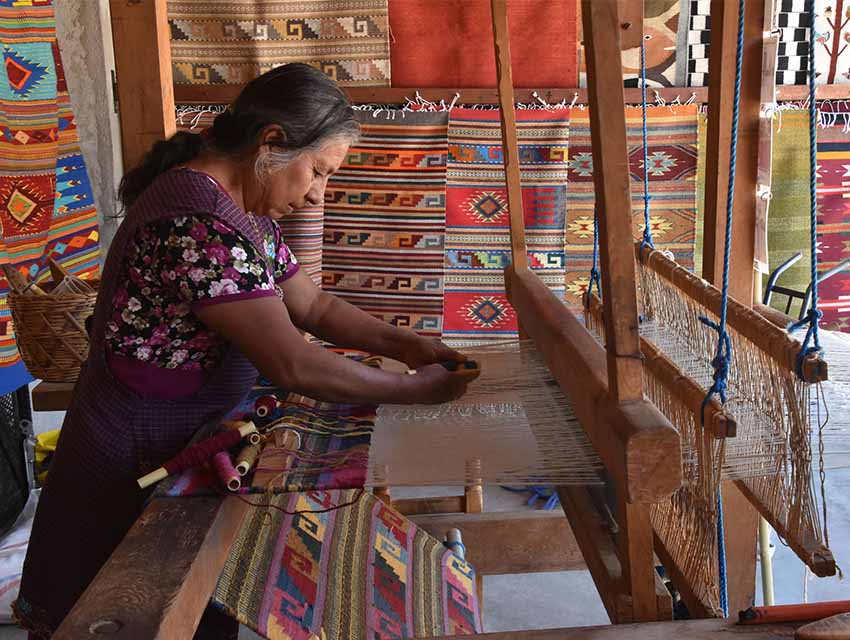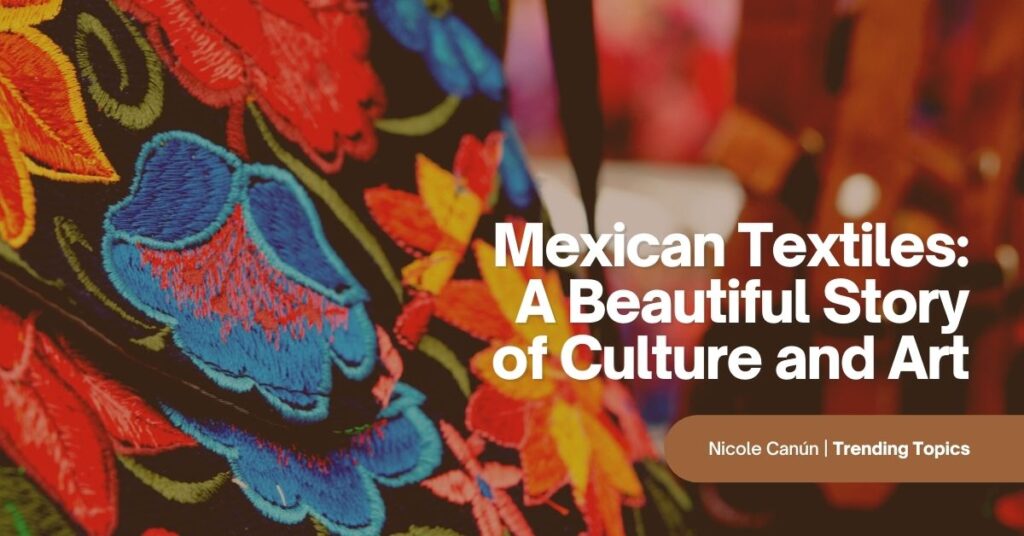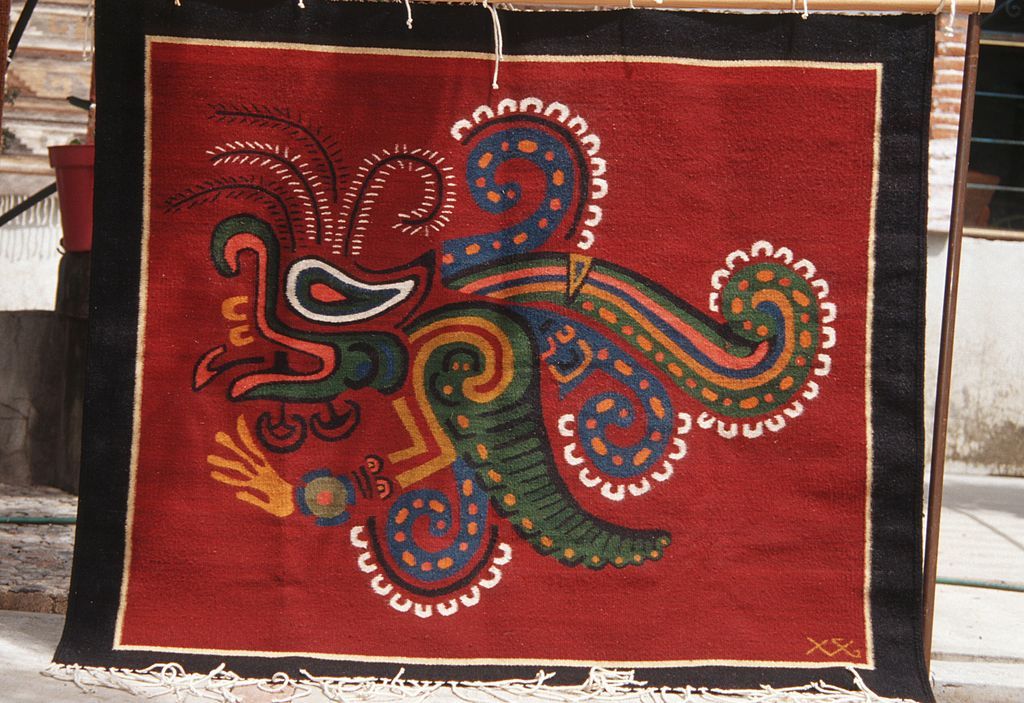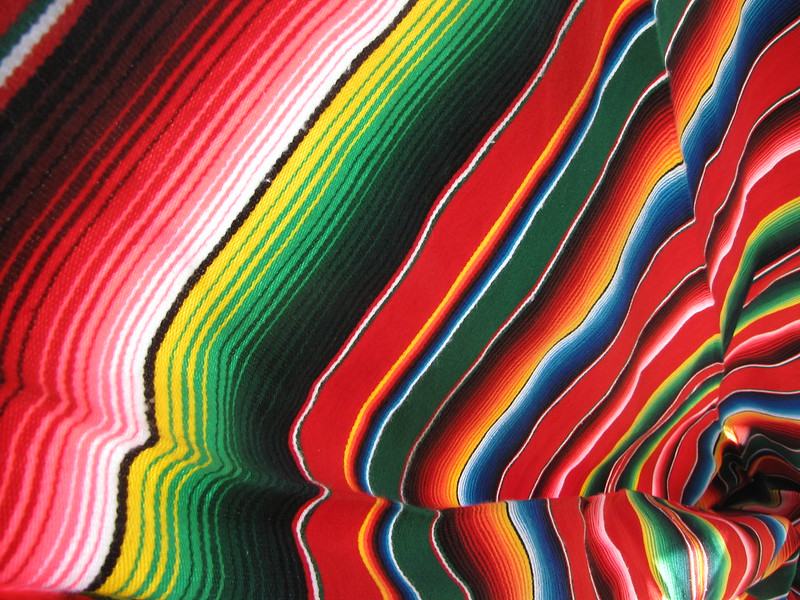Have you ever wondered about the beautiful textiles that come from Mexico? The vibrant colors and intricate designs are truly captivating. In this article, I’m going to take you on a journey to uncover the rich artistry of Mexican weaving. Get ready to be amazed by the skill and creativity that goes into creating these exquisite textiles!
When it comes to weaving, Mexico is a true paradise. From the bustling markets of Oaxaca to the tiny villages in Chiapas, you’ll find weavers passionately crafting their masterpieces. Each region has its unique style and technique, making Mexican weaving incredibly diverse.
One of the most notable aspects of Mexican weaving is the use of natural dyes. Did you know that artisans in Mexico often extract vibrant colors from plants, insects, and minerals? It’s truly a fascinating process that has been passed down through generations.
Not only are the colors extraordinary, but the designs are also incredibly intricate. From geometric patterns to intricate motifs inspired by nature, Mexican textiles are a true feast for the eyes. The skill and attention to detail that goes into each piece is simply remarkable.
In the upcoming article, you’ll learn more about the different regions in Mexico known for their weaving traditions. We’ll also take a closer look at the techniques and materials used to create these stunning textiles. Whether you’re a textile enthusiast or simply curious about Mexican culture, this article will give you a deeper appreciation for the rich artistry of Mexican weaving. So stay tuned and prepare to be captivated by the mesmerizing world of Mexican textiles!

Unveiling the Rich Artistry of Mexican Weaving
Mexico is a country renowned for its rich cultural heritage and vibrant art forms. One such art form that holds a special place in Mexican culture is weaving. The exquisite textiles created through this ancient craft tell intricate stories of tradition, mythology, and the people who dedicate themselves to the art. In this article, we will delve into the captivating world of Mexican weaving, exploring its history, techniques, symbolism, and regional diversity. Join us on this journey as we celebrate the timeless beauty and artistry of Mexican weaving.
The History of Mexican Weaving
Ancient Origins and Pre-Columbian Weaving
The roots of Mexican weaving can be traced back thousands of years to the ancient indigenous civilizations such as the Maya and the Aztecs. These skilled weavers used backstrap looms, one of the earliest and most traditional weaving techniques, to create their intricate textiles. Weaving played a significant role in their societies, with textiles being used for clothing, ceremonial purposes, and as a medium of artistic expression.
The Influence of Indigenous Cultures
Throughout Mexico’s history, indigenous weaving traditions have maintained their presence and influence. The diverse indigenous cultures each have their distinct weaving techniques and styles, often incorporating intricate patterns and symbols that hold deep cultural significance. The remarkable craftsmanship of these indigenous weavers continues to be passed down through generations, preserving ancient traditions and techniques.
Weaving during the Spanish Colonial Period
The arrival of the Spanish conquistadors in the 16th century brought significant changes to Mexican weaving. The Spanish introduced European techniques and materials, such as the foot loom and sheep’s wool, which became integrated into the existing indigenous practices. This fusion of cultures resulted in a unique and diverse weaving tradition that blended European influences with traditional indigenous techniques.
Revolutionary Movements and Weaving
The early 20th century witnessed various revolutionary movements in Mexico, which had a profound impact on the weaving industry. During this time, indigenous weaving became emblematic of Mexican identity and was celebrated as a symbol of resistance against oppression. Weavers played an essential role in preserving Mexican culture and striving for social and economic independence.
Modernization and Global Influences
In recent decades, Mexican weaving has faced challenges due to modernization and the growing influence of mass-produced textiles. However, there has been a resurgence in the appreciation for handmade crafts and a movement towards supporting local artisans and preserving ancient techniques. The combination of traditional knowledge and contemporary designs has allowed Mexican weaving to thrive in a global marketplace, gaining recognition for its unparalleled beauty and cultural significance.

Traditional Techniques and Materials
Backstrap Loom Weaving
The backstrap loom, a portable and versatile tool, is the most traditional and widely used weaving technique in Mexico. It consists of a simple warp setup attached to a weaver’s waist with one end secured to a stationary object. This weaving method allows for intricate patterns and fine detail in the textiles. Weavers skillfully manipulate the warp threads to create carefully crafted textiles.
Foot Loom Weaving
Foot loom weaving, introduced during the Spanish colonial period, became another prevalent technique in Mexican weaving. The foot loom allows for faster and larger-scale production compared to the backstrap loom. This method requires the weaver to use their feet to control the tension of the warp threads. Foot looms are commonly used in regions such as Oaxaca and Chiapas, where textile production is on a larger scale.
Natural Fibers: Cotton, Wool, Agave
Mexican weavers have a deep connection with the natural resources found in their surroundings. Traditional textiles were primarily woven using natural fibers such as cotton, wool, and agave. Cotton, known for its softness and breathability, was cultivated and spun by indigenous communities. The introduction of sheep’s wool by the Spanish colonialists brought new possibilities to Mexican weaving. Agave fibers, obtained from the sturdy leaves of the agave plant, were used to create sturdy and durable textiles.
Natural Dyes and Coloring Techniques
The vibrant colors found in Mexican textiles come from natural dyes derived from plants, minerals, and insects. Cochineal, a small insect found on cacti, was used to create the iconic red color. Indigo, obtained from the leaves of the indigo plant, provided a rich blue hue. Mexican weavers also used various plant materials such as annatto seeds, marigolds, and pomegranate rinds to create a spectrum of shades. These natural dyes not only produce stunning colors but also contribute to the environmental sustainability of the craft.
Intricate Patterns and Symbolism
Geometric Designs and Mathematical Precision
Mexican weaving is characterized by its intricate geometric patterns, showcasing the weavers’ mastery of mathematical precision. These patterns are often inspired by ancient cosmological beliefs, representing the intertwining of the physical and spiritual worlds. The precise calculations required to create these patterns demonstrate the deep cultural knowledge and interconnectedness of the weavers with their surroundings.
Nature-Inspired Motifs
Drawing inspiration from the rich biodiversity of Mexico, many traditional Mexican textiles feature nature-inspired motifs. Flowers, birds, animals, and plants are often depicted in vibrant colors, symbolizing the connection between humans and the natural world. These motifs pay homage to the ancient belief systems that celebrated the harmony between humans and nature.
Symbolism in Mexican Weaving
Mexican textiles are filled with meaningful symbols that reflect the weavers’ cultural heritage and beliefs. For example, the intertwined snakes motif represents the duality of life and death, while the peyote cactus motif holds spiritual significance in indigenous cultures. Each symbol tells a story, representing cultural identity, ancestral knowledge, and the weavers’ connection to their communities.
Religious and Mythological Imagery
Religion plays a vital role in Mexican culture, and this is often reflected in the textiles created by Mexican weavers. Traditional textiles may feature religious imagery, such as depictions of saints, crosses, and other religious symbols. Mythological creatures and deities also find their way into the designs, evoking stories and beliefs that have been passed down through generations.

Colors and Dyes: A Vibrant Palette
Traditional Color Palette
Mexican textiles are known for their vibrant and bold color palette. Traditional color combinations include rich shades of red, blue, green, and yellow. These colors not only catch the eye but also hold cultural significance, representing various elements of Mexican culture and spirituality.
Introduction of Synthetic Dyes
With the arrival of synthetic dyes in the 19th century, Mexican weavers gained access to a broader spectrum of colors. The introduction of synthetic dyes brought new possibilities for artistic expression, enabling weavers to experiment with vibrant hues previously unattainable with natural dyes. Despite this, many weavers continue to practice and advocate for the use of natural dyes, as they hold cultural and environmental significance.
Significance of Colors in Mexican Culture
In Mexican culture, colors hold profound meaning and often represent different aspects of life. Red symbolizes passion and courage, while blue represents purity and spirituality. Green is associated with fertility and growth, and yellow represents light and warmth. Each color used in Mexican weaving carries its own significance, contributing to the overall depth and storytelling in the textiles.
The Role of Women in Mexican Weaving
Historical Significance of Women Weavers
Throughout Mexican weaving history, women have played a fundamental role in preserving and advancing the craft. Weaving has traditionally been a female-dominated practice, with women passing down their skills and knowledge through generations. The intricate textiles created by women weavers are a testament to their dedication, creativity, and resilience.
Weaving as a Cultural Tradition
Weaving is deeply ingrained in Mexican culture and serves as a cultural tradition that connects communities. Women weavers proudly uphold their cultural heritage through their craft, ensuring that ancient techniques, patterns, and symbolism continue to thrive. Weaving is not merely an activity but a way of life, an embodiment of Mexican identity and the stories of generations past.
Empowerment through Weaving Cooperatives
In recent years, weaving cooperatives have emerged as a means of empowering women and creating sustainable livelihoods. These cooperatives provide women with fair wages, access to resources, and opportunities for skill development. By working collectively, women weavers gain a stronger voice and the ability to influence their own economic, social, and cultural futures.
Challenges and Opportunities
While women weavers have made significant contributions to Mexican weaving, they continue to face challenges. The rapid modernization of the textile industry and the availability of cheap, mass-produced textiles pose threats to the livelihoods of traditional weavers. Efforts are being made to address these challenges through education, advocacy, and the promotion of fair trade practices, enabling women weavers to continue their craft and secure a brighter future for themselves and their communities.

Regional Styles and Cultural Diversity
Textiles of Oaxaca
Oaxaca, located in southern Mexico, is renowned for its diverse textile traditions. Indigenous communities such as the Zapotec and Mixtec have preserved their weaving techniques for centuries. The textiles of Oaxaca are known for their intricate designs, vibrant colors, and the use of natural dyes. Each community within Oaxaca has its unique weaving style, preserving the region’s rich cultural heritage.
Tapestry Weaving in Teotitlán del Valle
Teotitlán del Valle, a village in Oaxaca, is celebrated for its exceptional tapestry weaving. Using the foot loom technique, the weavers of Teotitlán create intricate designs known as “tapetes.” These tapestries often depict scenes from everyday life, local legends, and symbols from Zapotec mythology. The weavers’ craftsmanship and attention to detail make each tapestry a true work of art.
Huipil Traditions in Chiapas
The state of Chiapas is known for its vibrant and intricately embroidered huipiles, traditional blouses worn by indigenous women. Each village in Chiapas has its distinct style of huipil, with designs reflecting the community’s cultural identity and history. The huipiles of Chiapas are recognized for their vibrant colors, exquisite embroidery, and the incorporation of traditional symbols.
Sarape and Rebozo Weaving in Central Mexico
In central Mexico, the states of Jalisco and Guanajuato are famous for their sarape and rebozo weaving traditions. The sarape, a long, colorful blanket, and the rebozo, a versatile shawl, are iconic symbols of Mexican culture. These textiles are woven using the foot loom and adorned with intricate designs and patterns. The craftsmanship and artistry found in sarapes and rebozos are a true reflection of Mexico’s weaving heritage.
Unique Textile Traditions in Yucatán
The Yucatán Peninsula is home to unique textile traditions shaped by the Mayan culture. The region is known for its exquisitely embroidered huipiles, hammocks, and embroidered linens. The weavers of Yucatán employ intricate embroidery techniques, often using vibrant colors and geometric patterns. These textiles not only serve practical purposes but are also valued for their cultural importance and aesthetic beauty.
Famous Mexican Weaving Communities
Temoaya: Center of Otomi Embroidery
Located in the State of Mexico, Temoaya is known as the center of Otomi embroidery. The Otomi people have a rich textile tradition, producing vibrant and intricately embroidered textiles. Their textiles often feature animals, plants, and mythological creatures, showcasing the Otomi’s connection to nature and their spiritual beliefs.
Santa María del Río: The Rebozo Capital
Santa María del Río, a town in the state of San Luis Potosí, is famous for its rebozos. Here, traditional rebozo weaving techniques have been preserved and handed down through generations. The weavers of Santa María del Río are renowned for their expertise in weaving intricate patterns and using vibrant colors, making their rebozos highly sought after by collectors and enthusiasts.
Zinacantán: Home of the Beloved Chamula Blankets
In the highlands of Chiapas, Zinacantán is a village known for its weaving traditions. Zinacantecos, the indigenous people of Zinacantán, weave beautiful textiles, including the beloved Chamula blankets. These blankets, made from sheep’s wool and adorned with intricate designs, are cherished for their warmth and cultural significance. The weavers of Zinacantán continue to honor their traditions and contribute to the preservation of Chiapas’ rich weaving heritage.
Tenancingo: Renowned for Its Sarape Weaving
Tenancingo, located in the state of Mexico, is renowned for its sarape weaving tradition. The weavers of Tenancingo skillfully create vibrant and intricately patterned sarapes, demonstrating their mastery of the craft. The cultural significance and exceptional craftsmanship of Tenancingo sarapes have earned them recognition both in Mexico and internationally.

Preservation and Revival Efforts
Protecting Traditional Techniques
Efforts are being made in Mexico to preserve traditional weaving techniques by passing down knowledge from generation to generation. Organizations, schools, and communities are working together to ensure that these techniques are safeguarded, allowing future generations to continue the craft. The transmission of skills and the preservation of ancient knowledge are vital to maintaining the authenticity and cultural heritage of Mexican weaving.
Reviving Endangered Weaving Styles
In some cases, indigenous weaving styles and traditions are at risk of disappearing due to social and economic challenges. However, dedicated individuals and organizations are working tirelessly to revive these endangered weaving styles. By offering support, resources, and opportunities for weavers to showcase their craft, these efforts contribute to the revitalization and sustainability of unique weaving traditions.
Preserving Indigenous Cultural Heritage
Preserving indigenous cultural heritage is an integral part of the efforts to protect Mexican weaving. Through initiatives that involve collaboration with indigenous communities, researchers, and artisans, the knowledge and stories that are woven into every textile are celebrated and honored. By understanding the cultural significance of Mexican weaving, we can better appreciate the value it holds as an art form and as a part of Mexico’s identity.
Contemporary Innovations and Adaptations
Combining Traditional and Modern Designs
Contemporary weavers in Mexico are embracing the fusion of traditional techniques and modern designs. While honoring the intricate craftsmanship of their ancestors, these weavers incorporate innovative patterns, colors, and styles into their textiles. By merging tradition with contemporary aesthetics, Mexican weavers are expanding the horizons of the craft and ensuring its relevance in today’s diverse and evolving world.
Experimentation with New Materials
While natural fibers have traditionally been used in Mexican weaving, some contemporary weavers are exploring new materials to create unique textures and appearances. This experimentation with materials such as silk, bamboo, and recycled fibers adds a fresh dimension to Mexican weaving, enhancing its versatility and appeal.
Weaving in Art Installations
Mexican weaving has transcended beyond the boundaries of functional textiles and found its place in art installations. Contemporary artists are incorporating woven elements into their works, blurring the line between art and craft. These installations not only showcase the artistic potential of Mexican weaving but also spark conversations about tradition, culture, and identity.
Weaving Techniques in Contemporary Sculpture
Weaving techniques have also found their way into contemporary sculpture, expanding the possibilities of the craft. Mexican sculptors incorporate woven elements into their works, creating captivating and thought-provoking pieces. This integration of weaving techniques and sculpture demonstrates the versatility and adaptability of Mexican weaving in the modern art world.
Mexican Weaving in Fashion and Interior Design
Fashion Designers Collaborating with Weavers
Mexican fashion designers recognize the cultural richness and artistic value of Mexican textiles and have started collaborating with traditional weavers. These collaborations bring together contemporary designs and traditional weaving techniques, resulting in stunning fashion collections that pay homage to Mexico’s rich weaving heritage. Such partnerships also create economic opportunities for weavers and promote the value of handmade textiles.
Weaving Techniques in Haute Couture
Mexican weaving has also made its mark in haute couture. Internationally acclaimed fashion designers have incorporated traditional Mexican weaving techniques into their collections, celebrating the beauty and intricacy of Mexican textiles. From stunning embroidered gowns to intricately woven accessories, these haute couture creations showcase the limitless possibilities of Mexican weaving in the world of fashion.
Decorating Homes with Mexican Textiles
Mexican textiles have become increasingly popular in interior design, as people seek to bring the vibrant colors and cultural significance into their homes. From handwoven rugs and pillows to intricately patterned curtains and upholstery, Mexican textiles add a unique touch and evoke a sense of warmth and cultural heritage. Incorporating Mexican textiles into home decor not only beautifies the space but also supports local artisans and preserves Mexican weaving traditions.
Mexican Weaving as a Global Trend
Mexican weaving has gained significant popularity as a global trend in fashion and design. Beyond Mexico’s borders, people are drawn to the artistry, vibrant colors, and cultural richness found in Mexican textiles. From designer runways to homes around the world, Mexican weaving has captured the hearts of many, becoming a symbol of authenticity and appreciation for handmade craftsmanship.
The Economic Impact of Mexican Weaving
Weaving as a Source of Income
For many artisans in Mexico, weaving is not only a cherished cultural practice but also a vital source of income. Weaving provides an economic opportunity for individuals and communities, particularly in rural areas where alternative employment options may be limited. The sale of handwoven textiles provides a sustainable livelihood for many weavers and their families, contributing to their economic well-being.
Economic Importance for Local Communities
Mexican weaving holds significant economic importance for local communities. The production and sale of textiles have a positive economic ripple effect, supporting local businesses, markets, and tourism. Weaving cooperatives and organizations that promote fair trade practices ensure that the economic benefits of weaving reach the communities where the craft is deeply rooted, fostering sustainable development.
Sustainability and Fair Trade in Weaving
In recent years, there has been an increased focus on sustainability and fair trade practices in the weaving industry. Organizations and initiatives have emerged, aiming to protect the environment, preserve traditional techniques, and ensure fair wages for artisans. By supporting sustainable and ethical practices, consumers contribute to the longevity and empowerment of the weaving communities in Mexico.
Appreciating the Handmade Craftsmanship
Meticulous Artistry and Attention to Detail
The artistry of Mexican weaving is a testament to the meticulousness and dedication of the weavers. Each textile is created with care and attention to detail, requiring hours of intricate work. The precision of their techniques and the intricate patterns they weave demonstrate the master craftsmanship that goes into every textile, making them truly stunning works of art.
Hours of Dedication in Every Piece
The creation of a single textile often involves countless hours of labor and skillful craftsmanship. From preparing the materials to setting up the loom and weaving the intricate patterns, each step requires time, patience, and expertise. The commitment and dedication of Mexican weavers to their craft is evident in the beautifully crafted textiles they create.
Understanding the Value of Handmade Goods
In a world dominated by mass production, the value of handmade goods often becomes overshadowed. However, Mexican weaving reminds us of the unique beauty and intrinsic value of handmade craftsmanship. Each textile carries with it the stories and cultural heritage of the weaver, making it a truly exceptional piece. By appreciating the value of handmade goods, we support the preservation of traditional techniques and the livelihoods of artisans.
Impacts of Tourism on Mexican Weaving
Tourism has both positive and negative impacts on the weaving industry in Mexico. On one hand, increased tourism provides opportunities for artisans to sell their textiles to a larger market, enhancing their economic prospects. The exchange of cultural knowledge and appreciation through tourism also contributes to the preservation of weaving traditions.
However, tourism can also bring challenges. The demand for cheaper and mass-produced textiles can negatively affect local artisans, as visitors often seek lower-priced alternatives. Additionally, the desire for “authentic” souvenirs can lead to exploitation or appropriation of indigenous designs. It is crucial for tourists to be mindful of their purchasing decisions and support local artisans and fair trade practices to ensure a positive impact on the weaving communities.
Conclusion: Celebrating a Timeless Art Form
From ancient origins to contemporary expressions, Mexican weaving stands as a testament to the artistry and cultural richness of Mexico. Each textile tells a story, honoring the history, traditions, and spiritual beliefs passed down through generations. The beauty and intricacy of Mexican weaving captivate the hearts and minds of all who appreciate the art form.
By unveiling the rich artistry of Mexican weaving, we celebrate the skill, dedication, and cultural significance embodied in every thread. Through support and appreciation, we ensure the preservation of this timeless craft, empowering Mexican weavers and fostering a deeper understanding of the diverse and fascinating culture of Mexico.
So next time you encounter a handwoven Mexican textile, take a moment to marvel at the intricate patterns, vibrant colors, and the stories woven into every thread. Embrace the artistry and cultural richness of Mexican weaving, knowing that each piece represents more than just a textile, but a celebration of a timeless and cherished art form.